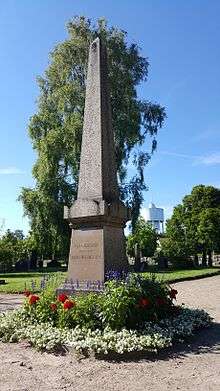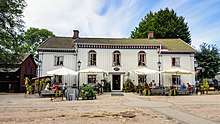Märta Ljungberg
| Marta Liungberg | |
|---|---|
 The burial obelisk at The Old Cemetery marks the place where it is believed Märta Ljungberg, and her husband, lied buried under the church floor. | |
| Born |
May 26, 1656 Ljungby Gård |
| Died | October 4, 1741 (aged 85) |
| Cause of death | Accident, with old age |
| Burial place |
Gamla Kyrkogården, Ljungby 56°50′09″N 13°56′02″E / 56.835788°N 13.933771°E |
| Monuments |
Märta Ljungberg's Memorial Stone, Gamla Torg, Ljungby Märta Ljungbergsvägen, Ljungby (Arterial thoroughfare ) |
| Spouse(s) | Lars Tåckenström (1681-1714) |
| Children |
Samuel (son) Unknown name (son) |
| Parents |
|
| Relatives |
Abraham Ljungberg (brother) Five other siblings |
Marta Liungberg (modern spelling: Märta Ljungberg) (1656–1741), was a Swedish innkeeper. She managed the important inn at Ljungby in Sunnerbo. She was also a successful farmer, who acquired many of the farms around the area of the inn. In 1828, when it was decided that a city should be founded in Sunnerbo, Ljungby (at that time only a couple of farms around the inn), was chosen to be founded upon the land donated by her in her will.



Before the inn
Märta Ljungberg grew up on Ljungby Gård (English: Ljungby Farm) together with her parents and six siblings.[1] She was daughter to frälseinspektor and innkeeper Lars Svensson Frimolin and his wife Margareta Larsdotter.[2]
The inn
After her parents death the ownership of inn was taken over by her brother Abraham Ljungberg (later Ljungfelt) with the everyday operation handed over to Märta herself. Instead her brother makes a career as a landskamrerare for the county. During the next four years the thingstead in Hamneda and the marketplace in Berga was moved to Ljungby.[1][2] In 1681 she marries with the häradsfogde Lars Tåckenbo. Four years later, 1685, Lars gets transferred to Stockholm around the same time they get their first child, the son Samuel. Eight years later Lars gets transferred to Halmstad. They now have a second son, but he only lives for eight days.[1]
It will take several years, into the 1700s, before Lars gets transferred to Ljungby under Göta Court of Appeal. Meanwhile, her son Samuel is studying in Lund and becomes captain lieutenant. However, he was hit by the Asian plague and dies in 1710 at age 25. Four years later her husband, Lars, dies at Angelstad rectory.[1]
After her brother's death in 1724, she was required to pay a retroactively annual lease of the inn to her nephews. After her refusal to pay the inn was ceded to them in 1729, when Märta was 73 years of age.[2]
The testament
In the autumn of 1741 Märtha Ljungberg hurts her hip when she falls off a wagon. She later dies on October 4, 1741, 85 years old. After a three months long public display she was buried by dean Olof Osander.[1][2] During her life she managed to take over twelve farms; including Eskilsgården, Södergården, and Klockaregården that today is located in and around Ljungby's Old Marketplace.[1]
Before her death, she decided that the proceeds of her estate should go to scholarships for students of Smålands Nation in Lund and the poor in Ljungby, Kånna och Angelstad's parishes.[2] Her nephews was disinherited.[1]
In 1754 the inn burns to the ground, but is later rebuilt between 1818 and 1820 in its current form.[1] When in 1828 a discussion about the construction of a new city in Sunnerbo, Ljungby was elected because of this donation. The city of Ljungby was then built on the ground donated by Märtha Ljungberg.